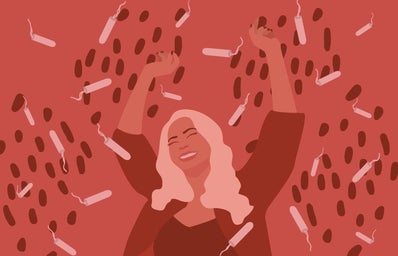In the modern world, we are programmed to be multi-taskers; we are mothers, husbands, sisters, sons, professionals, and embroider a whole host of other roles. In fact, the pace at which the majority of humanity lives almost seems to drift it too easily into the left lane, at 100 mph. Amidst the chaos of steering through daily life and routine, health is horribly neglected. An unchecked box on the “To-Do” that remains at the bottom of a growing list. Our health, however, is not defined by doctor visits, regular exercise, and leafy greens; it is a delicate balance that still exists between all background noise, especially pertaining to females who menstruate and have regular menstrual cycles.
Historical contract
More and more, the modern American society is putting women’s menstrual health on cruise control, leaving many women uneducated about their unique cycles and the sheer importance each has in their personal lives. This is partly enabled by the capitalist flair of American society and the heavy emphasis it places on attaining financial stability and a steady income; women work continuously to prioritize their needs and their families, to put food on the table, and simply keep up with the sprinting speed at which the world moves. However, the “busy world” we have created is a fallacy in itself; it mirrors a masculine foundation, an agentic social approach, rather than a more outwardly collaborative ground. Society has become centered around man’s 24-hour biological cycle of living; rise with the sun and rest with the moon, when in reality, women follow an entirely different pattern, the 28-day lunar cycle. Our hormonal bandwidth is extraordinary, and it is much different than that of the average man. Our attention to detail, energy levels, mood, and bodily needs are different almost every single day of these 28 when most men are accustomed to the normal 24-hour range of vitality. An example can be seen from a comparison between social conventions and the man’s hormonal cycle. Men have peak testosterone in the morning, which tapers until it falls in the evening. So what does this indicate? Higher testosterone in males is the biological marker of vitality and energy, hence, the man is primed to wake up and has the energy to remain focused through a productive day, and then when his testosterone naturally declines around the early evening, he is more passive and ready to rest. Matching this information with the normal workday in a modern society, where one works from early morning, say around 8 am to early evening, 4-5 pm, it is clear that the average workday is a parallel to a man’s hormonal profile, at least in terms of best channeling his general energy and attentiveness towards his own productive benefit. In contrast, the menstruating female will experience several days of high energy and productivity, and several days of low focus and attentiveness periodically throughout her cycle, and her natural fluctuations in her vitality are shown to be limiting in this type of social construct. Honing in on this small social example itself is indicative of one of the many ways in which the Western world is crafted seamlessly according to the male’s natural cycles, and is incredibly exclusive for women attempting to gain success in the same playing field. The American working world is a designer product, but it is one that is solely made for men.
Hormonal input
Most women are aware of their menstrual cycles only when they actually bleed, however many are left unaware of the gaps in between red; and how the body remodels its own health in 28 days. For most menstruating women, we follow 2 separate cycles of red; a uterine and an ovarian cycle, and each is encompassed by 4 distinct phases, each of which has its own distinct effects on our hormones, therefore, our mood, appetite, social and physical activity, and sleep, to name a few. The more notable uterine cycle begins the first day a woman bleeds, this is the commonly known menstrual cycle, when estrogen and progesterone, the more notable “feminine” hormones are at their lowest points, creating lower mood and energy levels, and the menstruating woman may display a distinct change in behavior such as seeking fatty foods and carbohydrates in greater quantities to replenish herself. The second phase is the follicular phase, this is when estrogen and progesterone climb back up, along with follicular stimulating hormone (FSH), which revitalizes the missing energy and creates a prime time for women to resume high-intensity activities, like exercise. The third phase is the ovulatory phase, and this is when the luteinizing hormone is at its peak, making the conception of a child highly favorable, therefore, some studies even note, other biological factors are actuated here, such as pheromones, and even slight facial feature changes, etc. Lastly, there is the luteal phase, which leads up to the period itself, hence, estrogen and progesterone decline, which commonly segways into the “PMS” phenomena observed in women anticipating their menstrual phase. Understanding hormonal profile changes in each phase solidifies why we may react and behave differently in each of the approximate 28 days because women who menstruate simply cannot be expected to be exactly the same each and every single day of their cycles. Based on the hormonal changes alone, it is clear that factors vital to achievement in modern Western society are heavily compromised throughout the approximated 28-day cycle; a woman in her luteal phase might not perform as sharply as a woman in her ovulatory phase. A woman in her follicular phase will lift heavier weights than a woman in her menstrual phase. The timing and duration of all phases of each cycle are also catered to each individual woman experiencing them; no single cycle, no single woman will display any of the above in any congruent way. Furthermore, shuttling this information forward for women is vital to our good health. Women educated in what each of the four phases implies to their own wellness are able to take advantage of each and finally achieve optimal health.
Social Implications
We are aware that wellness is a sage-green-colored topic that retains links to social and mental ideologies. For menstruating women following the 4 phases of their lunar cycles, social health will be another facet to take into consideration when seeking overall comprehension of their health. How women socialize and interact with their contemporaries during this time can be predicted or even attributed to their hormonal changes as well as mood changes described above. The menstruating women’s mood in itself, is a ship that is anchored by the chains of hormonal inputs, specifically by the powerful tides of estrogen and progesterone, that have the helpful ability to manipulate dopamine and serotonin, our “happy” neurotransmitters. Therefore, when women menstruate, and their estrogen and progesterone levels fluctuate, their mood is also going to alter their emotional and interactive states. In observational practice, many individuals are quick to assume a woman on or expecting her period acts grouchy, mean, and unapproachable. The truth of the matter is that this is likely due to the dip in estrogen and progesterone she experiences at that time, and she simply needs solitude, as her dopamine and serotonin will both also be lower, making her more socially depleted and with lower attention and focus. When looking at the follicular phase, menstruating women are typically much more outgoing, and open to new experiences, as they have restored some of their focus and energy back from the previous phase, and their hormones are surging back up again. It is quite commonly noted that women here will share a greater social capacity, are found socializing in larger groups, and reflect an overall brighter persona, especially leading into the third phase of their cycles, ovulation, where they have their highest social appetite, most notably with members of the opposite sex. During the ovulatory phase, the luteinizing hormone will be the hormonal marker that causes this noticeable shift into their inviting behavior, and women might also experience increased self-confidence, and motivation here, due to a slight peak in dopamine and serotonin again. However true this may be for women who do experience these emotional shifts a lot of women might not ever feel this way, in regards to mood. There are many women, maybe on certain medications, or experiencing life’s stressful transitional changes, that will not feel the same in every cycle. Ultimately, what determines what we feel is derived from the cloth on an individual basis; menstrual health is a custom-made brand, and it is our responsibility to alter its measurements to our own respective needs.
Threading it together
Optimal health has different definitions for each individual seeking it, however for menstruating women, it is crucial to consider what each of the four phases indicate when crafting a lifestyle that is sustainable and can direct them toward their desired wellness and health goals. An example that I follow myself, and highly recommend, is catering my social interactions and physical workouts to my cycle. I know that when I am at my follicular phase, right after menstruation, I have higher energy and alertness, hence I aim to lift heavy and mix cardio into my routine more readily. I also tend to spend more time studying with my friends in public settings where side interactions are inevitable. In contrast, when I approach the end of my approximate 28-day cycle I find it harder to move my body as fluidly, and I opt to do pilates or yoga instead and tend to reside in my apartment at all times of the day. This flexibility has allowed me to reap greater benefits in my mental and physical health, rather than simply forcing myself to abide by the same binding sticky routine each and every day of my cycle. In the past, I have observed that when I would do this, my sleep, appetite, and focus were all extremely compromised, so much so that I constantly felt exhausted in my daily activities and found it hard to concede activities I truly enjoyed. Making that knowledgeable switch is what has driven me towards true wellness and brought necessary components back into my journey to better my own health. It truly is more sustainable in the long-term, to work in accordance with the biological clock within me, rather than relying on a rigid copy-paper calendar. The very first step to the dotted start line might be to simply begin tracking our menstrual cycles and mood during the span of the days that fall in between bleeds. When planning out what routines might best benefit themselves, menstruating women might also want to account for their own intuition and lean more heavily into the idea of “gut feelings.” The body communicates with us, every single day, and women who are able to listen to it, to comprehend the tiny cues it indicates and sets forth to them, are more attuned to their own energy and are able to attain a lifestyle that is most authentic and helpful in their individual pathways to wellness.
While the Western public has done a phenomenal job of including menstruation within the textbook, of promoting access to genuine women’s healthcare, and educating girls globally about their bodies, it is still yet to complete its roundtrip journey to a final destination. Menstrual health is a vital component of general health that holds necessary truths within it, therefore, educating ourselves, others, and anyone who is curious about the topic is the first step towards acknowledging and sparking awareness of what health and well-being encapsulate. Health, while being defined as a physical practice, is ultimately built from a foundation of mental awareness in thought and being, even one that is made of pink and red bricks.
A-comparison-of-the-female-vs-male-hormonal-cycle-spoiler-alert-women-have-it-worse


